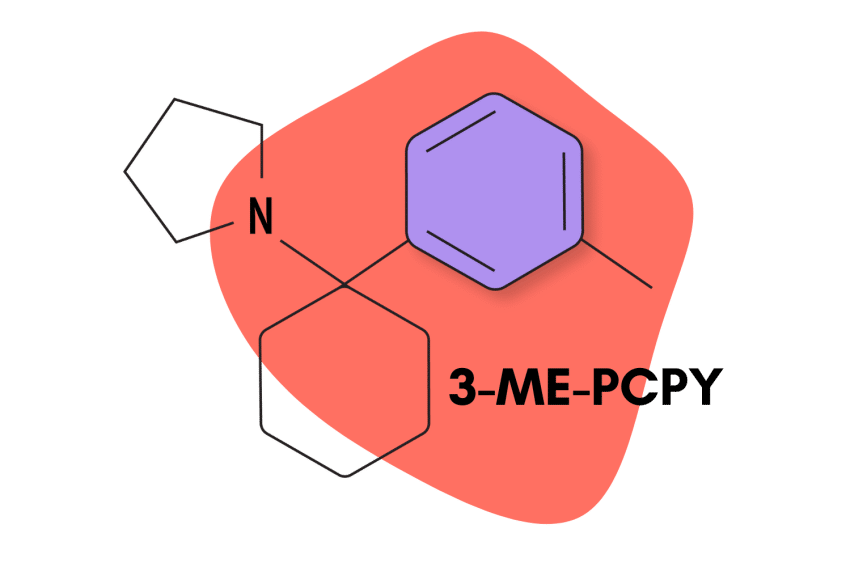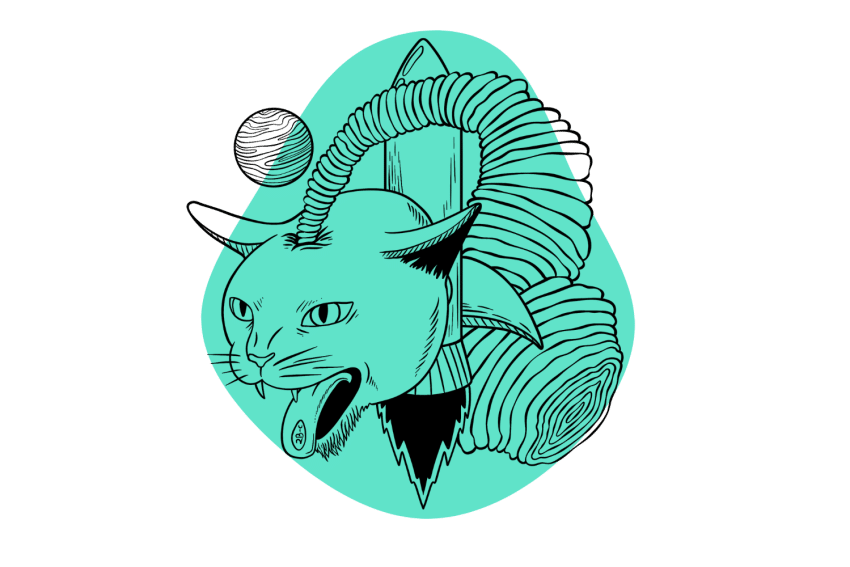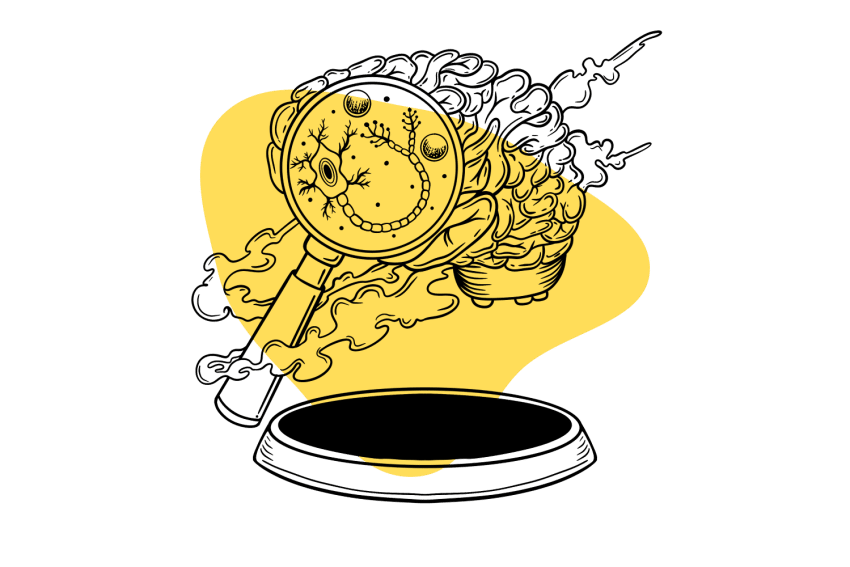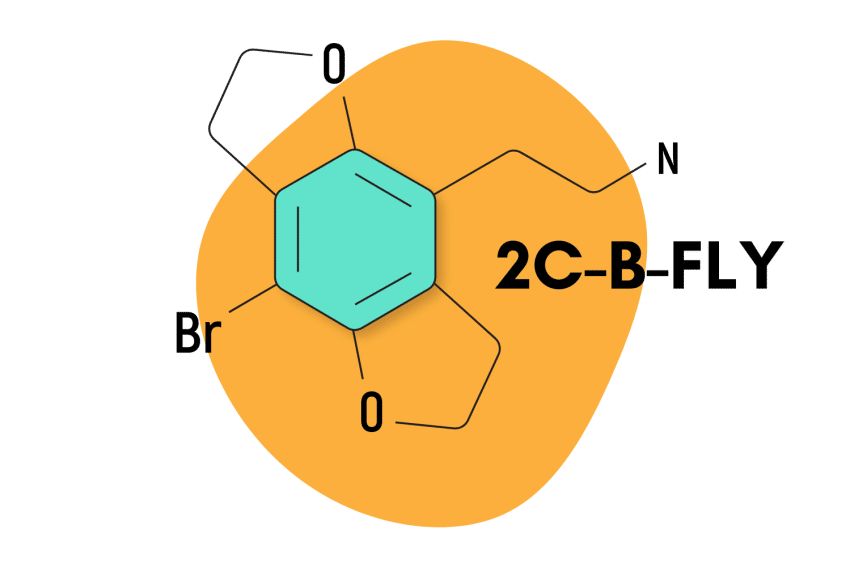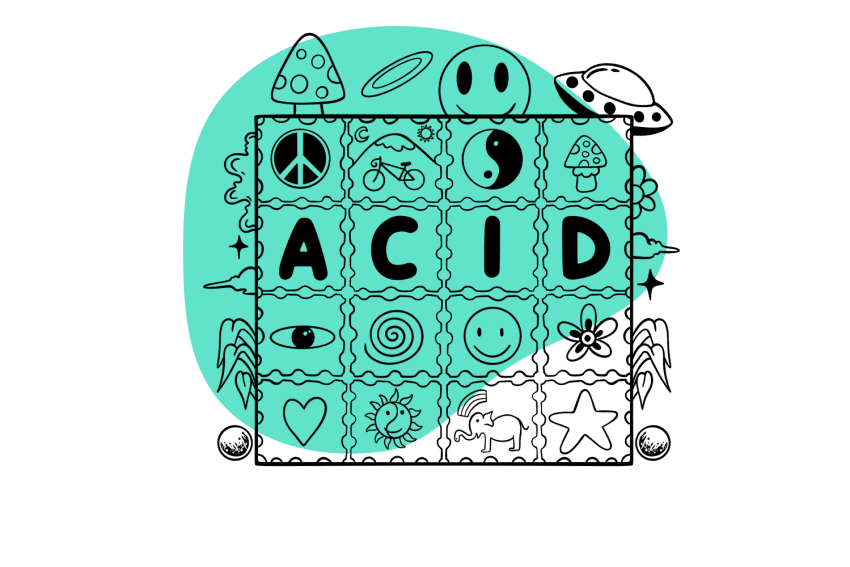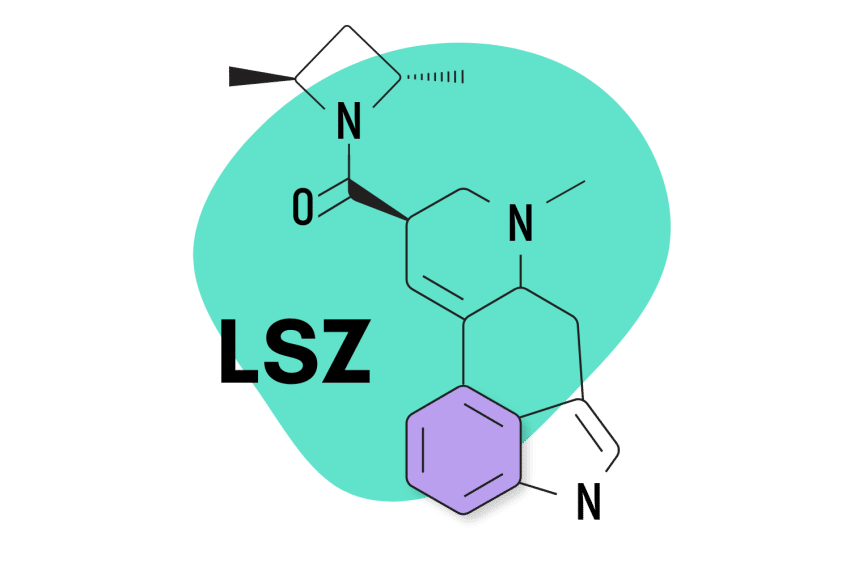What’s The Default Mode Network?
This complex neural network might be the source of your ego.
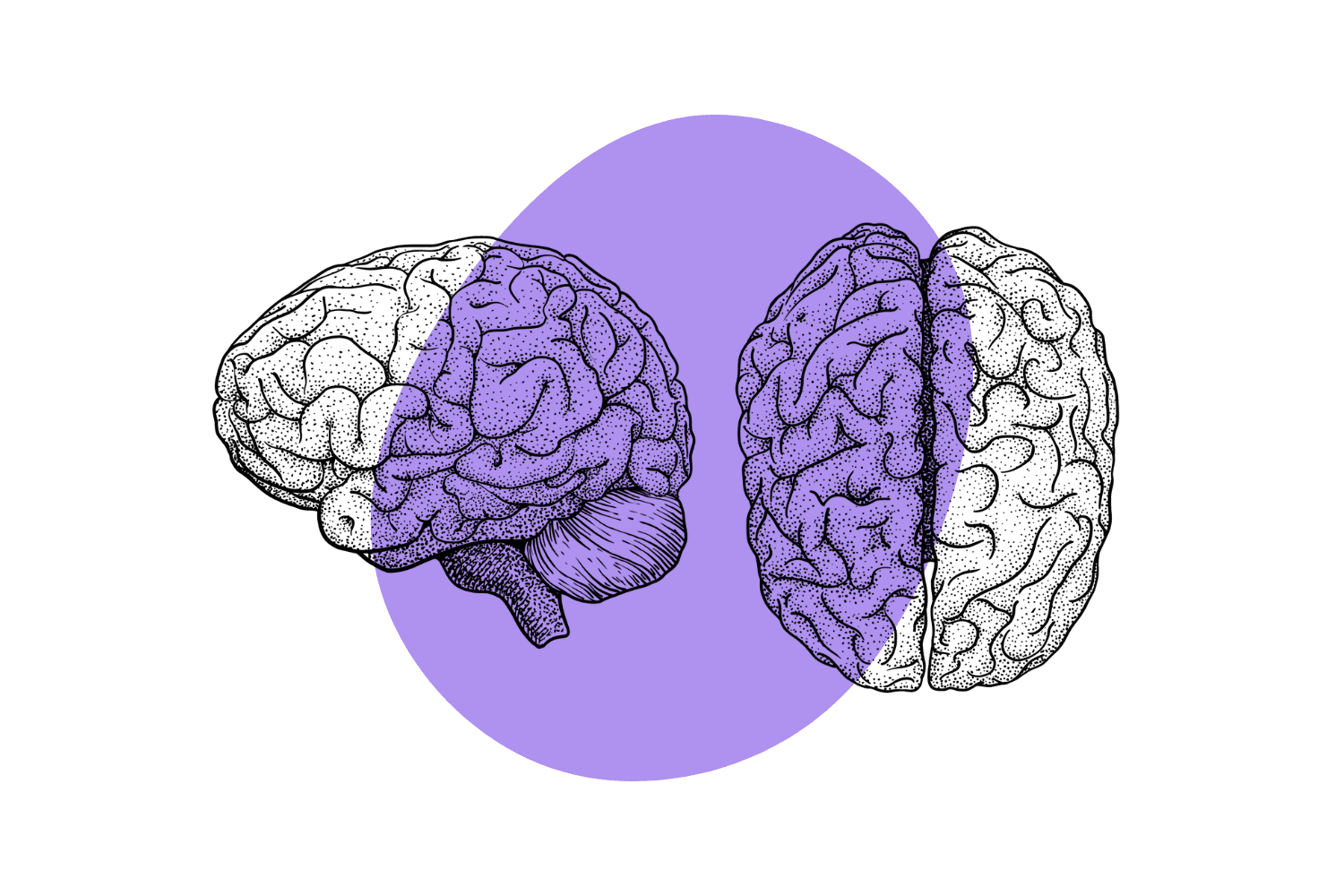
The human brain is made up of billions of neurons, each one individually connected to several thousand others.
Modern tools, such as fMRI machines, have allowed us to map out what we call “functional brain networks.”
These networks consist of separate regions that activate together to perform a certain type of function — such as visual interpretation, problem-solving, or instinctual behaviors and urges.
The network we’re going to cover is the default mode network (DMN for short). We’ll discuss what makes this network so advanced and how psychedelics are thought to increase entropy in the brain through the DMN to make us more creative and open-minded.
First of All, What Are Brain Networks?
The brain is made up of neurons; each one is connected to many other neurons nearby.
These connections form seven distinct large-scale brain networks. These networks activate together to perform a certain type of cognitive task.
For example, the visual network performs the functions necessary to provide our visual interpretation of the world.
The 7 large-scale brain networks include:
- Visual network
- Limbic network
- Dorsal attention network
- Ventral attention network
- Salience network
- Front-parietal network
- Default mode network
What is The Default Mode Network (DMN)?
The default mode network is one of the seven large-scale brain networks. It’s responsible for abstract thoughts, rumination, theory of mind, remembering the past, projecting the future, and defining our understanding of the “self.”
The latter point makes many people view the DMN as the “physical location of the ego.”
Whenever we’re not doing anything that requires our direct attention to the outside world, the DMN becomes active. This is why we often ruminate or daydream when we don’t have anything to do.
Likewise, when we’re focused on a given task or trying to solve a specific problem in the outside world, the DMN becomes inactive.
Recently, there’s been evidence to suggest that psychedelics (such as LSD or psilocybin) are able to “suppress” the DMN — which is thought to be one of the mechanisms in which psychedelics can induce ego-death experiences [3, 4] and promote problem-solving skills and more creative, out-of-the-box thinking.
What Does the DMN Do?
The DMN is responsible for abstract thought processes. It’s part of the neocortex — the latest advancement in biological brain evolution and one of the main differentiators between human and animal brains. The neocortex has three main networks that make up higher brain function — the DMN, the central executive network (CEN), and the salience network (SN).
The DMN can be thought of as the “voice” in your head. It’s what determines your feeling of “self-worth” and allows you to empathize with what other people are thinking or feeling by imagining yourself in their position. It’s also deeply involved with our ability to imagine past events and project the future.
The DMN is important for making our minds more efficient. It gives us a basis for what “self” is — which gives us a reference point and allows us to engage with the physical world around us. This is what creates the beliefs and assumptions we have about the world and our relationship to it.
The DMN also acts as a “reducing valve” or “maestro” by keeping the activity of all the other large-scale brain networks in check. It controls the entropy or chaos brought on by other brain regions [2].
Entropy is a term taken from thermodynamics that essentially means “chaos” or “randomness.” We’ll dive into more detail about the entropic brain theory and how it relates to the DMN and psychedelics later.
The point here is that the DMN keeps the brain to help prevent us from being overwhelmed by our thoughts and emotions. It filters the sensory information that enters the brain, as well as the information generated from other regions of the brain itself. It makes our thoughts more efficient by preventing information overload.
The DMN essentially acts as a reducing filter for the sensory information we take in from the world around us to categorize and make sense of it.
The same is true in the other direction — the DMN filters information coming from other regions of the brain to avoid overwhelming us and keeping our train of thoughts more efficient and focused.
In this way, the DMN acts as a reducing valve for the flow of information going in and coming out of our brains.
Functions of the DMN include:
- The perception of time
- Projecting the future
- Imagining & visualizing past memories
- Imagination & rumination
- Suppression of entropy (chaos or randomness) of other brain regions
- Separation of “self” and “other”
- Theory of mind (imagining the thoughts & feelings of others)
- Story comprehension (understanding & remembering a narrative)
Problems With The DMN
The DMN offers a huge advantage for how we think, process information, and interact with the world around us — but there are some downsides.
The highly structured nature of secondary consciousness states the DMN creates can make us more egotistical, more biased in our thinking and has been linked with numerous mental health disorders such as anxiety, depression, obsessive-compulsive disorder, and autism.
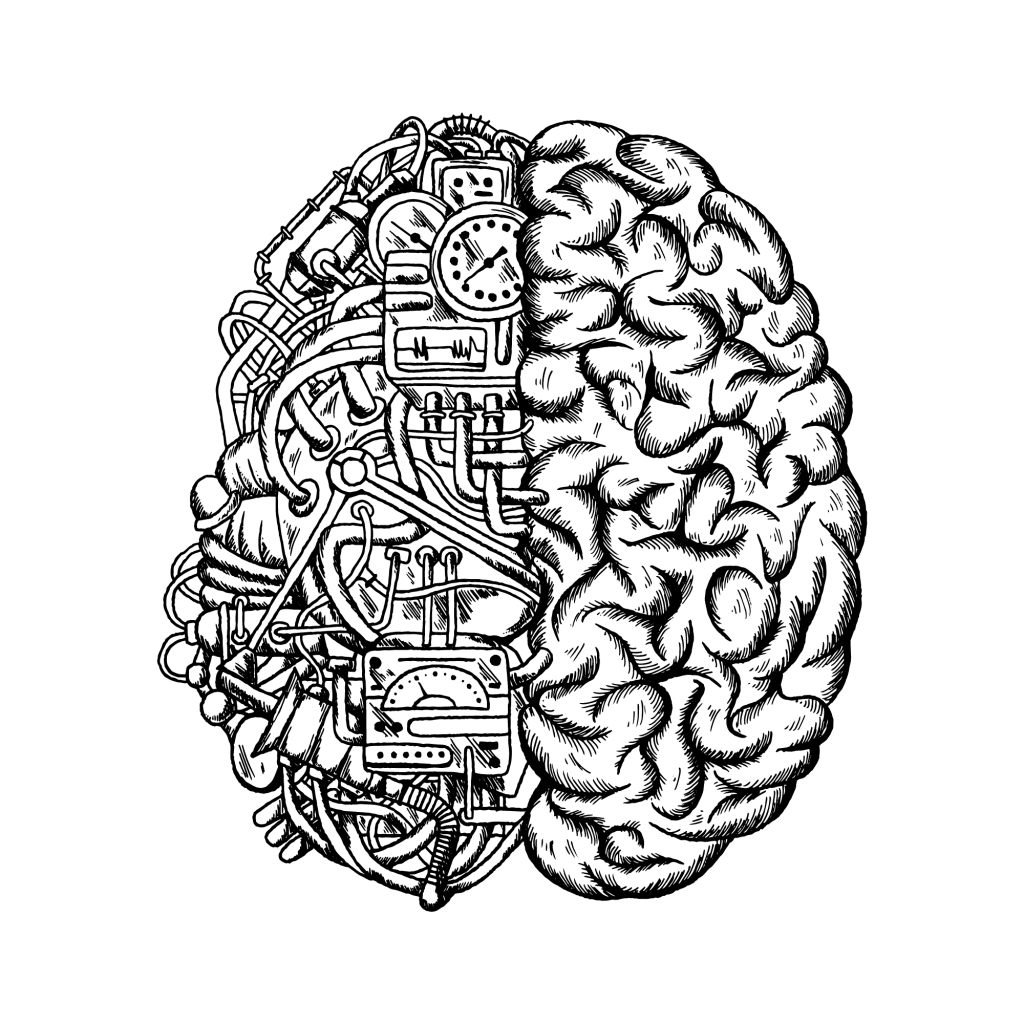
The Default Mode Network & Ego
One of the core functions of the DMN is to protect our concept of self-image and self-esteem. It does this by selectively shutting out thoughts or sensory information that don’t adhere to our constructed view of self-image or identity.
This essentially describes our ego.
To maintain our concept of self, we need rigidity in our thinking. This means we need to form beliefs or assumptions about the world and our relationship to it. We form beliefs surrounding who we are, what our value is in the world, and what we can expect from other people or aspects of our environment.
There’s a lot of attention around the role of psychedelics and ego dissolution — but it’s been oversimplified in the media over the last couple of years. The idea is that suppressing the DMN leads to the ego-dissolution experience. While there’s some evidence to support this, it has yet to be quantified by scientific research.
Other studies suggest the salience network (another large-scale brain network largely integrated with the DMN) also plays a key role in the dissolution of ego after using psychedelics. We’ll cover the salience network in more detail later.
The DMN & Mental Health
We experience and navigate the world through our beliefs and assumptions. These beliefs act as a filter to take the chaos of life and existence and convert it into something more manageable.
It’s largely the DMN that regulates and forms these beliefs that allow us to find structure and patterns in the world.
We need to have these beliefs and structures to function as humans. Without it, we sink into chaos where anything can happen at any moment, and we become unable to differentiate between what’s “real” and what isn’t.
On the flip side, if our beliefs and assumptions are too strong, we can create an enclosed view of the world outside of these beliefs and assumptions. It creates biases in our thinking and can lead to negative mind states like depression or anxiety.
The DMN is also considered relevant in neurological disorders such as Alzheimer’s disease, post-traumatic stress disorder (PTSD), schizophrenia, autism, and attention deficit hyperactivity disorder (ADHD).
Psychedelics & The DMN: Entropic Brain Theory
The interaction between psychedelics and the default mode network is incredibly complex, and there’s a lot of contradiction in how the two are linked.
This field of research is still in its early years, so most of what we’re about to cover is just theory at this point — so keep that in mind.
Dr. Carhart-Harris put forward one of the leading theories on this subject — the entropic brain theory. The theory suggests that psychedelics work to enhance entropy in the brain [2].
Entropy is a concept used in thermodynamics that describes the transition of a system from being highly ordered to disordered and chaotic.
There are essentially two states of consciousness that the DMN controls:
- Primary consciousness (↑ Entropy) — No entropy suppression by the DMN. Hyperassociative, illogical and contradictory, extreme and rapid changes in emotion. This consciousness state is only achievable through deep meditation or psychedelics. It’s also the form of consciousness found in young children.
- Secondary consciousness (↓ Entropy) — Strong entropy suppression by the DMN. Logical, constrained, rule-based, realistic, and rational. This is our normal waking consciousness.
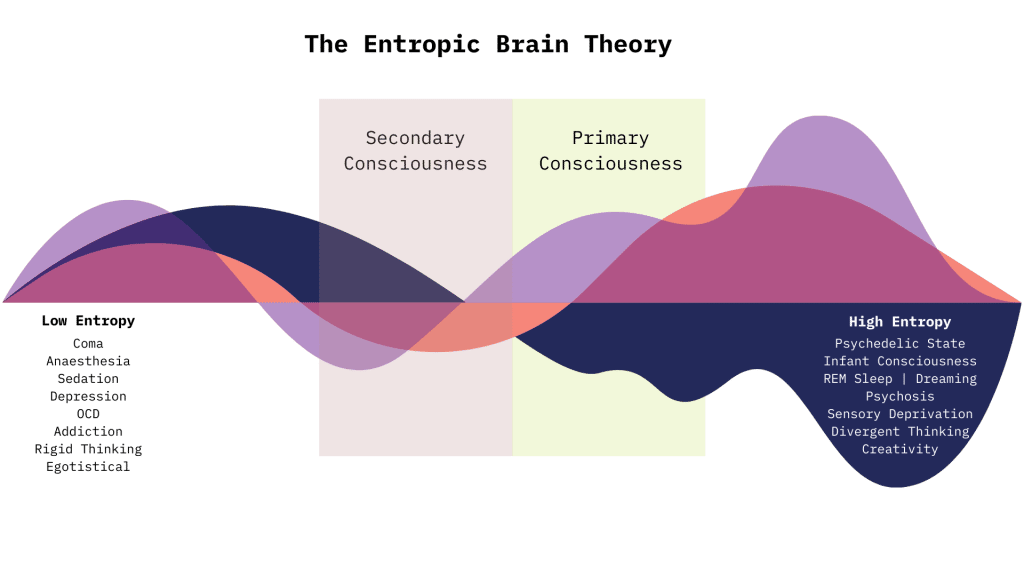
The general idea is that certain psychedelics — such as LSD, psilocybin, mescaline, or DMT — increase activity throughout the brain but decrease activity in the DMN. It’s been likened to the concept of “defragmenting a computer.”
When we suppress the DMN, it essentially turns off the reducing valve that controls the brain’s lower regions and allows for a higher entropy state [6]. This effectively transitions us closer toward a primary state of consciousness and allows more memory information to bubble up to the higher regions of the brain.
We become more in touch with the way we’re feeling, we experience a greater level of empathy towards others, we’re more creative, and it opens us up to new ideas and information we may have previously ignored.
In simple terms, psychedelics temporarily increase entropy and reduce the rigidity of thoughts, which provides a unique opportunity to access and integrate new information and update our beliefs and assumptions in a positive and life-affirming way.
This is considered one of the primary ways psychedelics can reduce addictive tendencies, anxiety, obsessive-compulsive disorder, or other byproducts of rigid thought patterns [1].
The Triple Network Model
The DMN is just one of three large-scale networks that make up the neocortex — the brain’s largest, outermost region. The neocortex is considered the most recent “upgrade” in the evolution of brain development (triune brain hypothesis). It gives us such a dramatic advantage in intellect compared to other animals.
Brain development throughout evolution:
- The Mammalian Complex (V3) — higher cognitive function, reason, & thought
- The Paleomammalian Complex (V2) — emotions & behavioral responses
- The Reptilian Complex (V1) — instincts & basic survival functions
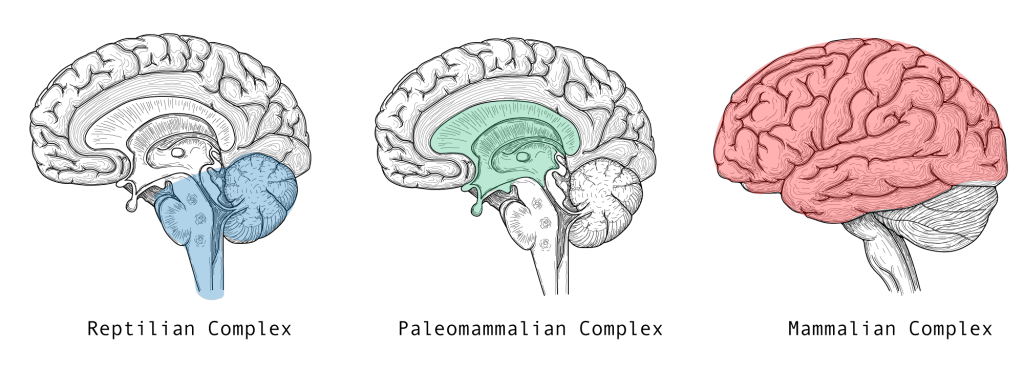
This region has the biggest impact on our ability to think about abstract ideas, solve complex problems, and set long-term goals.
The DMN works in tandem with these other networks to facilitate higher executive function, problem-solving, goal-orientated behavior, and imagination. These systems also offer tactical upgrades through a concept called salience — which is the ability to automatically determine what objects in our visual sphere are worth focusing on. It’s like having a built-in auto-aim feature.
This is collectively called the triple network model — which consists of three primary brain networks:
- The default mode network (DMN) — rumination, idle thought, perception of “self” or “ego.”
- The central executive network (CEN) — problem-solving, projecting the future, working memory.
- The salience network (SN) — detecting salient stimuli and interfaces the DMN and CEN.
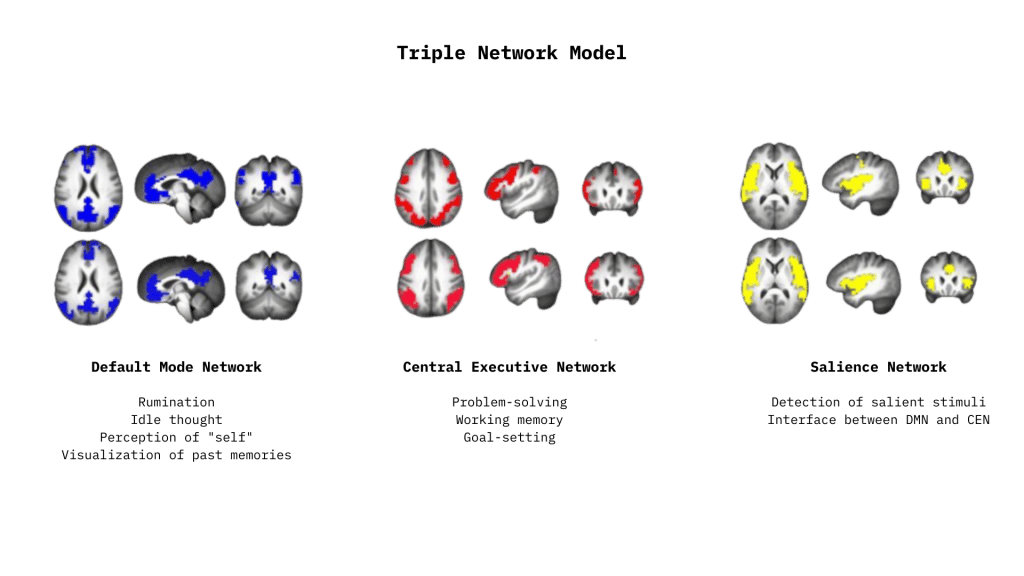
Let’s cover the role these other brain networks provide and how they relate to the DMN.
The Salience Network (SN)
The SN is involved in communication, social behavior, and self-awareness processes. It also acts as an interface between the DMN and CEN.
The name comes from its role in “tagging” things as being “salient” and automatically shifts our attention toward those salient stimuli (stimulus-driven attention).
Saliency is a word used in neuroscience to describe our ability to pick out objects, qualities, or states that are different from their neighbors. It’s what allows us to “notice things” and pay attention to them— such as getting a notification on our phone or noticing a meteor in a dark night sky. Both of these forms of stimuli automatically cause a shift in our attention toward the source.

The salient network is a key component of learning and intellect by detecting these changes and recruiting the other functional networks in response. It also serves as an interface to the CEN and DMN — calling each network to respond depending on the characteristics of given salient stimuli.
The SN is considered “bottom-up” in terms of cognitive processing. It doesn’t rely on memory to work, and it’s very fast and reactive. This goes in contrast to the “top-down” cognitive processes of the DMN and CEN that rely on drawing information from memory and using imagination to create projections for the future — such as reading or writing.
It’s difficult for the human brain to perform both bottom-up and top-down processes at the same time — so it tends to jump back and forth instead of doing both simultaneously.
Psychedelics & The Salience Network
The DMN tends to get all the credit as being the source of ego, and the suppressive actions of psychedelics on this brain region are thought to be the “cause” of ego dissolution. But it’s much more complicated than that. The salience network is also thought to play a key role in the ego-dissolution experience.
One hypothesis suggests the salience network may orchestrate the dynamic switching between mental states anchored by the DMN and externally driven attentional states to guide our behavior [6] — which is a core aspect of the ego.
Psychedelics, such as psilocybin, ayahuasca, and LSD, have all been shown to increase the entropy of the salience network and increase connectivity between the DMN and SN to produce states of ego-dissolution [7, 8, 9].
The Central Executive Network (CEN)
Other names for this system include the frontoparietal network (FPR). In some papers, this network is abbreviated as “ECN” instead of “CEN.”
This network is involved with sustained attention, complex problem-solving, and working memory. It’s most dominant during goal-oriented activities.
The CEN directly opposes the activity of the DMN.
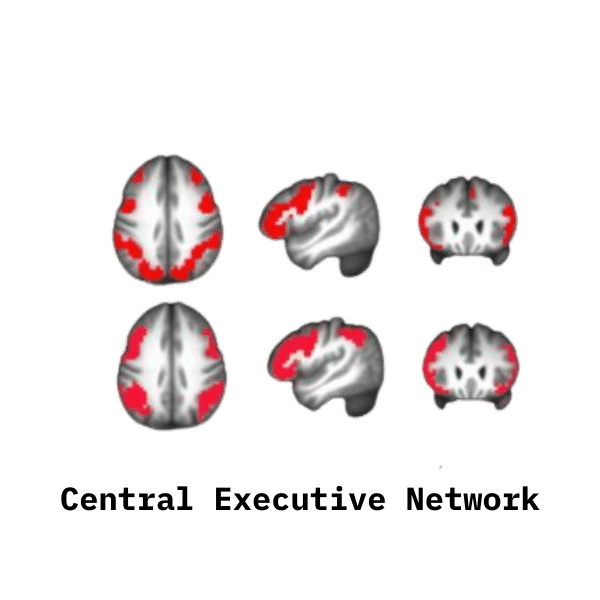
They work like yin and yang — when one is in control, the other is suppressed. The balance fluctuates throughout the day depending on what we’re doing.
When we’re focused on a task at hand or deeply involved with a tough problem, the CEN is most active.
When we’re no longer engaged, the CEN powers down to re-route cognitive energy toward the DMN instead. These two systems wax and wane depending on what we’re doing and what type of “thought” we need access to.
Final Thoughts: Psychedelics & The DMN
The default mode network is one of the three core networks that make up the higher regions of the human brain. The DMN, in particular, is associated with performing abstract thought processes such as rumination, imagination, projection of the future, visualization of past memories, and understanding and maintaining our perception of self vs. other.
The DMN acts as a reducing valve for information going into the brain, as well as thought processes performed by other brain regions. It creates a rigid structure to avoid overwhelming the mind and helps us interact with the world around us more efficiently and effectively.
However, this rigidity in thinking (secondary consciousness) can also lead to problems with cognitive bias, anxiety, depression, obsessive-compulsive disorder, addiction, and various other mental health diseases and egotistical tendencies.
When we take psychedelics, the DMN is suppressed — allowing for a higher degree of entropy among other brain regions (primary consciousness states). This gives us access to information that was otherwise filtered or ignored and allows us to revise our current beliefs and assumptions about the world and our relationship to it.
References
- Carhart-Harris, R. L., Roseman, L., Bolstridge, M., Demetriou, L., Pannekoek, J. N., Wall, M. B., … & Nutt, D. J. (2017). Psilocybin for treatment-resistant depression: fMRI-measured brain mechanisms. Scientific reports, 7(1), 1-11.
- Carhart-Harris, R. L., Leech, R., Hellyer, P. J., Shanahan, M., Feilding, A., Tagliazucchi, E., … & Nutt, D. (2014). The entropic brain: a theory of conscious states informed by neuroimaging research with psychedelic drugs. Frontiers in human neuroscience, 8, 20.
- Speth, J., Speth, C., Kaelen, M., Schloerscheidt, A. M., Feilding, A., Nutt, D. J., & Carhart-Harris, R. L. (2016). Decreased mental time travel to the past correlates with default-mode network disintegration under lysergic acid diethylamide. Journal of Psychopharmacology, 30(4), 344-353.
- Lebedev, A. V., Lövdén, M., Rosenthal, G., Feilding, A., Nutt, D. J., & Carhart‐Harris, R. L. (2015). Finding the self by losing the self: Neural correlates of ego‐dissolution under psilocybin. Human brain mapping, 36(8), 3137-3153.
- Papo, D. (2016). Commentary: The entropic brain: a theory of conscious states informed by neuroimaging research with psychedelic drugs. Frontiers in human neuroscience, 10, 423.
- Menon, V., & Uddin, L. Q. (2010). Saliency, switching, attention, and control: a network model of insula function. Brain structure and function, 214(5-6), 655-667.
- Lebedev, A. V., Lövdén, M., Rosenthal, G., Feilding, A., Nutt, D. J., & Carhart‐Harris, R. L. (2015). Finding the self by losing the self: Neural correlates of ego‐dissolution under psilocybin. Human brain mapping, 36(8), 3137-3153.
- Lebedev, A. V., Kaelen, M., Lövdén, M., Nilsson, J., Feilding, A., Nutt, D. J., & Carhart‐Harris, R. L. (2016). LSD‐induced entropic brain activity predicts subsequent personality change. Human brain mapping, 37(9), 3203-3213.
- Pasquini, L., Palhano-Fontes, F., & Araujo, D. B. (2020). Subacute effects of the psychedelic ayahuasca on the salience and default mode networks. Journal of Psychopharmacology, 34(6), 623-635.

